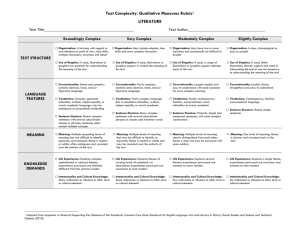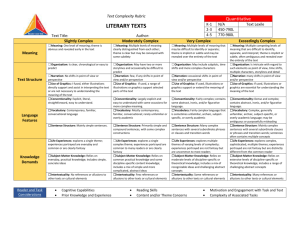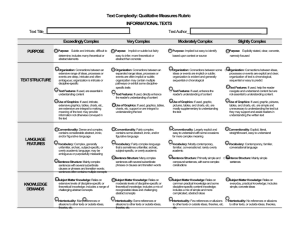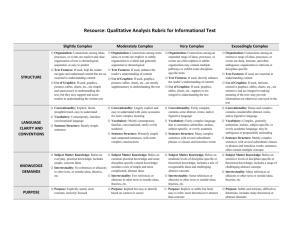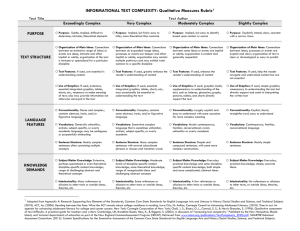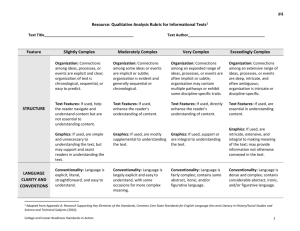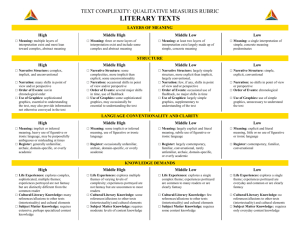text_complexity_qualitative_measures_lit_rubric_final_1_-1
advertisement
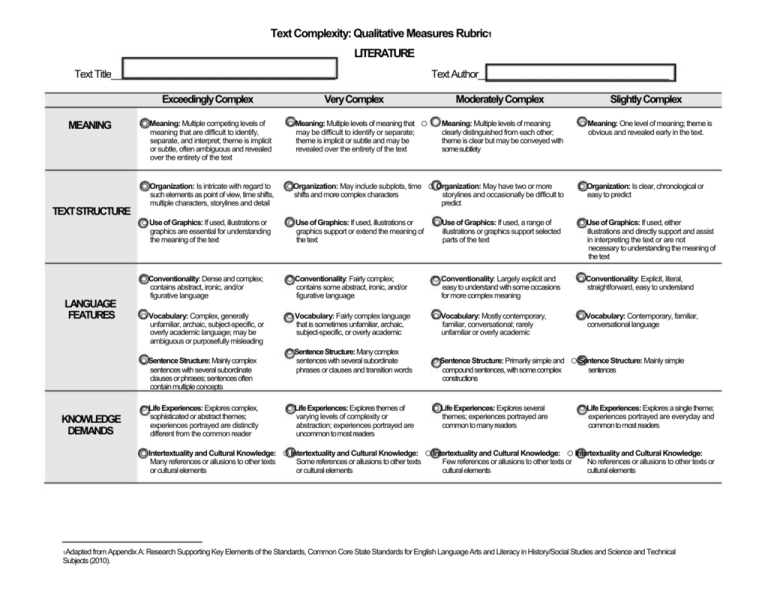
Text Complexity: Qualitative Measures Rubric1 LITERATURE Text Title___________________________________________ Exceedingly Complex MEANING o Meaning: Multiple competing levels of meaning that are difficult to identify, separate, and interpret; theme is implicit or subtle, often ambiguous and revealed over the entirety of the text o Organization: Is intricate with regard to TEXTSTRUCTURE such elements as point of view, time shifts, multiple characters, storylines and detail o Use of Graphics: If used, illustrations or graphics are essential for understanding the meaning of the text o Conventionality: Dense and complex; LANGUAGE FEATURES contains abstract, ironic, and/or figurative language o Vocabulary: Complex, generally unfamiliar, archaic, subject-specific, or overly academic language; may be ambiguous or purposefully misleading o Sentence Structure: Mainly complex sentences with several subordinate clauses or phrases; sentences often contain multiple concepts o Life Experiences: Explores complex, KNOWLEDGE DEMANDS sophisticated or abstract themes; experiences portrayed are distinctly different from the common reader Very Complex o Meaning: Multiple levels of meaning that o may be difficult to identify or separate; theme is implicit or subtle and may be revealed over the entirety of the text Text Author_____________________________________ Moderately Complex Meaning: Multiple levels of meaning clearly distinguished from each other; theme is clear but may be conveyed with some subtlety oOrganization: May include subplots, time o Organization: May have two or more shifts and more complex characters o Use of Graphics: If used, illustrations or graphics support or extend the meaning of the text o Conventionality: Fairly complex; contains some abstract, ironic, and/or figurative language storylines and occasionally be difficult to predict o Use of Graphics: If used, a range of illustrations or graphics support selected parts of the text o Conventionality: Largely explicit and easy to understand with some occasions for more complex meaning o Vocabulary: Fairly complex language o Vocabulary: Mostly contemporary, that is sometimes unfamiliar, archaic, subject-specific, or overly academic familiar, conversational; rarely unfamiliar or overly academic o Sentence Structure: Many complex sentences with several subordinate phrases or clauses and transition words o Life Experiences: Explores themes of varying levels of complexity or abstraction; experiences portrayed are uncommon to most readers Slightly Complex o Meaning: One level of meaning; theme is obvious and revealed early in the text. o Organization: Is clear, chronological or easy to predict o Use of Graphics: If used, either illustrations and directly support and assist in interpreting the text or are not necessary to understanding the meaning of the text o Conventionality: Explicit, literal, straightforward, easy to understand o Vocabulary: Contemporary, familiar, conversational language o Sentence Structure: Primarily simple and o Sentence Structure: Mainly simple compound sentences, with some complex constructions o Life Experiences: Explores several themes; experiences portrayed are common to many readers sentences o Life Experiences: Explores a single theme; experiences portrayed are everyday and common to most readers o Intertextuality and Cultural Knowledge: o Intertextuality and Cultural Knowledge: o Intertextuality and Cultural Knowledge: o Intertextuality and Cultural Knowledge: Many references or allusions to other texts or cultural elements Some references or allusions to other texts or cultural elements Few references or allusions to other texts or cultural elements No references or allusions to other texts or cultural elements 1Adapted from Appendix A: Research Supporting Key Elements of the Standards, Common Core State Standards for English Language Arts and Literacy in History/Social Studies and Science and Technical Subjects (2010).
